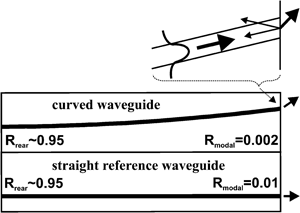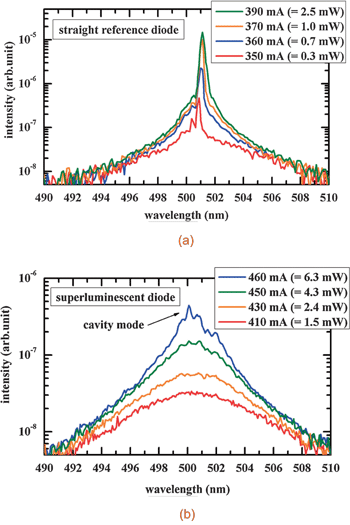- News
29 August 2012
Osram achieves cyan nitride semiconductor superluminescent LED
Germany’s Osram Opto Semiconductors GmbH has achieved super-luminescent light emission at wavelengths as long as 500nm in an indium gallium nitride (InGaN) diode [Fabian Kopp et al, Appl. Phys. Express, vol5, p082105, 2012]. Previously, InGaN super-luminescent light-emitting diodes (SLEDs) have been hindered at longer wavelengths due to low gain in the indium-rich active regions of these devices.
The researchers see SLEDs as an attractive option for projector applications. SLEDs combine the high light density and directionality of laser diodes with the broader emission spectrum of LEDs. The SLED operation uses stimulated emission effects to increase light output, but the devices are designed to avoid laser threshold.
For full-color operation one needs red, green and blue devices. At present, there are no SLEDs reported for the green spectral region (520-570nm). Although shorter-wavelength SLEDs have been achieved, as one increases the indium content to narrow the bandgap to access longer wavelengths, the gain of the material degrades due to deterioration in material quality. Fluctuations in indium concentration broaden the gain spectrum and reduce the peak gain.
Osram produced a SLED by curving the cavity of an edge-emitting device structure, similar to that of laser diodes (Figure 1). The purpose of the curving was to allow the rear facet to be highly reflecting for double-pass amplification of the light by stimulated emission, while at the same time to allow the out-couple facet to be slightly tilted, reducing its modal reflectivity to avoid lasing. Double-pass amplification effectively squares the gain of a single pass.
 Figure 1. Detailed drawing of planar waveguide with tilted facet and incident waveguide mode (top), curved waveguide with perpendicular rear and tilted out-couple facet (middle), and a straight reference waveguide (bottom).
Figure 1. Detailed drawing of planar waveguide with tilted facet and incident waveguide mode (top), curved waveguide with perpendicular rear and tilted out-couple facet (middle), and a straight reference waveguide (bottom).
The epitaxial material was grown on sapphire using metal-organic chemical vapor deposition (MOCVD). The InGaN quantum well light-emitting region was sandwiched between p- and n-type aluminium gallium nitride cladding and GaN waveguide regions. Ridge waveguides were formed that were 1200μm long and 2μm wide. The end facets had dielectric layers applied to give reflectivities of 95% (rear) and 1% (out-couple).
Two forms were given to the waveguide: in one, a traditional straight waveguide was formed with both facets perpendicular to the axis of the cavity; in the other, the waveguide was curved with a radius of around 34mm. The rear facet in the latter device was perpendicular to the light path, while the out-couple facet was tilted by around 2°. The tilting gave a calculated modal reflectivity of 0.2%.
The straight light-emitting device had an apparent threshold for lasing at ~400mA and showed a super-linear output power current characteristic. By contrast, the curved cavity device showed an exponential output power characteristic that is a typical behavior for SLEDs.
 The straight cavity device also had a narrower spectral peak around 501nm with full-width at half maximum (FWHM) of less than 1nm (Figure 2). The curved-cavity SLED had a peak at ~500nm with a much broader FWHM of 4.4nm when the output power was greater than 4mW (~450mA). At a higher current of 460mA, spectral modulation of the emission spectrum occurs, “because the higher gain compensates the low modal reflectivity of the tilted out-couple facet”.
The straight cavity device also had a narrower spectral peak around 501nm with full-width at half maximum (FWHM) of less than 1nm (Figure 2). The curved-cavity SLED had a peak at ~500nm with a much broader FWHM of 4.4nm when the output power was greater than 4mW (~450mA). At a higher current of 460mA, spectral modulation of the emission spectrum occurs, “because the higher gain compensates the low modal reflectivity of the tilted out-couple facet”.
Figure 2. Emission spectra for (a) the straight reference diode and (b) the super-luminescent diode at several currents driven in pulsed mode at a pulse width of 1μs, a duty cycle of 1%, and a temperature of 25°C.
The researchers found a blue-shift trend for the curved SLED at increasing current densities of 0.5kA/cm2, 1kA/cm2 and 20kA/cm2, of 526nm, 513nm, and 500nm, respectively. The 1kA/cm2 (~24mA/(1200μmx2μm)) level is the threshold current density of a good laser diode. The blue-shift is seen as the result of screening of the original polarization field of the InGaN structure, which red-shifts the emission spectrum, by increasing densities of free carriers at high currents.
The super-luminescent property of the emission was confirmed by the increase in degree of polarization of the light from 88% at 50mA to 98% at 450mA.
Osram InGaN SLEDs InGaN LED projectors
The author Mike Cooke is a freelance technology journalist who has worked in the semiconductor and advanced technology sectors since 1997.





